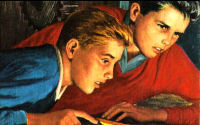

A brief history of the Hardy Boys
The Hardy Boys series is one of the most popular juvenile book series of all time. Its timeless plots, endearing characters, and exciting writing have helped keep the series alive for seventy-five years, while spawning and inspiring numerous spin-off series, nonfiction books, board games, TV shows, and internet sites. But how did it all begin?
The Stratemeyer Syndicate
Although he is said to be the author of every Hardy Boys book, there is actually no writer named Franklin W. Dixon. There never has been. For that matter, neither was there ever a Carolyn Keene, nor a Victor Appleton. These are all pen names for a group of writers established by a man named Edward Stratemeyer.
Since just before the turn of the century, hundreds of children's series books have sprung from Stratemeyer's fertile mind. His first major series was the Rover Boys, published from 1899 to 1926 under the pseudonym Arthur M. Winfield.
Stratemeyer soon found that he had far more ideas for stories and series than he could write on his own. He established a group of writers known as the Stratemeyer Syndicate. Stratemeyer would outline the basic plot of each book to be written, and one of the Syndicate writers (known as "ghosts") would write the book, being paid a flat fee and no further royalties. It was a system that seemed to work.
Most of the early Stratemeyer books were adventure tales. But in the mid-twenties, adult detective novels became popular, and the Stratemeyer Syndicate began to follow this trend.
The early years

The Hardy Boys Series began in 1927, when three "breeder" volumes (written by Leslie McFarlane under the name Franklin W. Dixon) were released: The Tower Treasure, The House on the Cliff, and The Secret of the Old Mill, published by Grosset & Dunlap. McFarlane, a Canadian journalist, wrote the first fifteen or so volumes of the series. He established the writing style that made the books so successful.
Early volumes were published in a cloth hardcover format with colour dust jackets. In 1962, the series switched to a new cover format with the cover art printed directly on the cover (no dust jacket). Collectors know this format as "picture cover" or "PC." This format was used for the Grosset & Dunlap books until 1987, when it was replaced by a laminated plastic cover.
In a process that angered loyal fans, the Syndicate systematically rewrote the Hardy Boys volumes 1-38 between 1959 and 1973. The changes were meant to bring the series more up to date and to eliminate the racial stereotypes that were occasionally found in the earlier volumes. As was said on the copyright page:
In this new story, based on the original of
the same title, Mr. Dixon has incorporated
the most up-to-date methods used by police
and private detectives.
The books became shorter (225 pages to 180, 25 chapters to 20) and the writing style was streamlined. The degree and type of revisions made varied considerably. Some revised stories were only touched-up versions of the originals, while others were totally new books that bore no resemblance to their predecessor except the title. Many people feel that the revised editions lost much of the charm and character that made the original Hardy Boys books so popular.
The present era
In 1979, Simon & Schuster acquired the rights for all new Hardy Boys books written by the Syndicate. The new publisher gave the books (and the Hardys) and all-new look, and paperback editions were published along with hardcovers. Simon & Schuster also published several spin-off books from the series, including The Hardy Boys Ghost Stories and Nancy Drew and the Hardy Boys: Super Sleuths.

The biggest spin-off series of all was the Hardy Boys Casefiles, which began in 1987. The Casefiles were aimed at an older audience than the other series, and presented readers with many changes from the original series. Joe's girlfriend Iola was killed off in the first volume, and the difference in personality between Frank and Joe became more pronounced. The stories became more "grown-up" as well: in the Casefiles, the Hardys view murder scenes and use guns. (One wonders whether Edward Stratemeyer would approve!)
However, the Casefiles proved to be much shorter-lived than the original mystery stories, and in 1998, after just over ten years of publication, the Casefiles series was cancelled. Ironically, the last volume was titled Dead in the Water.

Simon & Schuster announced another new Hardy Boys series in 1997: Frank and Joe Hardy - The Clues Brothers. The series was targeted at readers in grades three and four. However, due to lackluster sales, it was soon cancelled.
Despite the failure of Simon & Schuster's attempts to "modernize" the Hardy Boys, the books still remain popular today. In fact, it is the original Hardy Boys Mystery Stories, begun by Edward Stratemeyer in 1927, that have been the most successful. Simon & Schuster publishes several new volumes each year, and the Grosset & Dunlap reprints of the original 58 books (known to collectors as the Hardy Boys "Canon") still sell briskly. Trends may come and go, but it seems certain that the Hardy Boys are firmly rooted in the hearts and minds of readers young and old all over the world.
